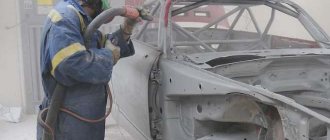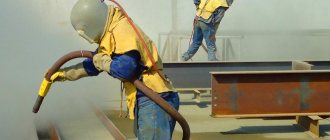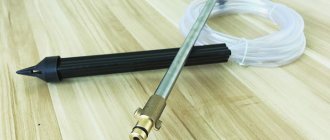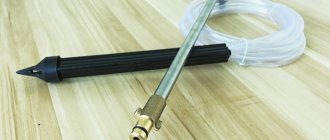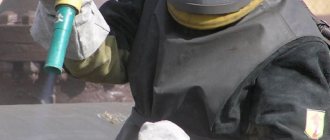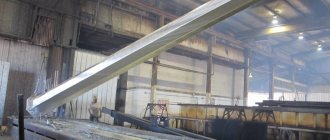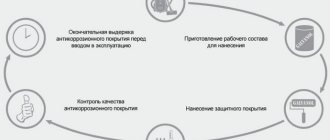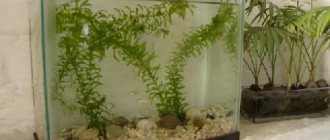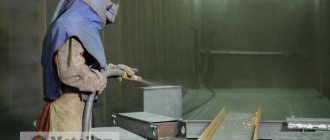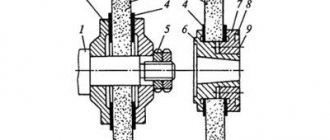From the outside, sandblasting resembles spray painting, when the metal caught under the jet changes its color. Only the surface is freed from coating and dirt and becomes matte, steel-colored.
There are different types of sandblasting used for specific purposes. Small sandblasting guns are used in everyday life. Industrial equipment is stationary, large and powerful.
What it is?
Sandblasting of metal is the mechanical removal of the top layer: rust and coating, due to numerous impacts of sand grains on the surface. Escaping from the nozzle under high pressure, the abrasive knocks out small particles of dirt, completely cleaning the metal.
A stream of sand is supplied by compressed air continuously, leaving behind a clean metal surface, removing from it:
- dirt;
- rust;
- oil stains;
- welding slags;
- paint;
- concrete and other building mixtures;
- primer.
What remains is a clean matte surface, ready for further processing.
Important!
Bitumen, tar and other viscous materials are difficult to remove by sandblasting. Abrasive particles stick to the top and are knocked out by the next stream of sand. Cleaning requires several times more sand and time. The exception is thermal sandblasting.
Degrees of preliminary surface preparation
The ISO standard defines 7 degrees of surface preparation. The following standards can be found in the specifications:
Preparation of surfaces manually or using power tools. Preparation includes scraping, wire brushing, mechanical brushing, and sanding (denoted by the letters “St”).
I. ISO-St Machining by hand and power tools Machining by hand and power tools. Before cleaning surfaces by hand or with power tools, thick layers of rust should be removed by chipping. Visible contaminants (oil, grease, dirt) are also removed. After cleaning, it must be cleaned of loose paint and dust.
II. ISO-St 2 Thorough cleaning by hand and power tools Thorough cleaning by hand and power tools. Upon visual inspection, the substrate should be clean from visible traces of oil, grease, dirt, paint, loose scale, rust and foreign matter.
III. ISO-St 3 Very thorough cleaning by hand and power tools Very thorough cleaning by hand and power tools. Essentially the same as St 2, but the substrate must be cleaned much more thoroughly - to a metallic shine.
Surface preparation by sandblasting (indicated by the letters “Sa”)
I SO-Sa Sandblasting Before sandblasting, thick layers of rust must be removed by chipping. Visible oil and grease stains and dirt are also removed. After sandblasting, the substrate must be cleaned of dust and debris.
IV. ISO-Sa 1 Light sandblasting Inspection with the naked eye should show that the surface is free of visible oil, grease and dirt, as well as loose scale, rust, paint and other foreign matter.
V. ISO-Sa 2 Thorough sandblasting. The degree of cleaning is at least 76% of the surface. Visually, the surface looks clean from oil, grease stains and dirt, from most scale, rust, paint and other foreign substances. Residual contamination has a tight fit.
VI. ISO-Sa 2.5 Very thorough sandblasting. Degree of cleaning - 96% clean surface. Inspection with the naked eye shows that the surface is cleaned of visible oil, grease stains and dirt, most of the scale, rust, paint, and other foreign substances. Residual traces of infection may only be present in the form of barely noticeable stripes and spots.
VII. ISO-Sa 3 Sandblasting to visually clean steel. The degree of cleaning is 99% of a clean surface. When examined with the naked eye, the surface looks cleared of stains of grease, oil, dirt, most of the scale and rust, paint and other foreign substances. The surface of the product must have a uniform metallic luster.
Note: Photos are for illustrative purposes only. They do not show the full extent of the preparation, which also includes cleaning operations, which are not visible from the photographs (colorless stains).
British, German and American equivalents
| ISO 8501-01 | ||
| SIS 05 59 00 | BS 4232 | SSPC-Vis 1 |
| DIN 55928 Part 4 | ||
| Sa 3 | 1st grade | White metal SP 5 |
| Sa 2.5 | 2nd grade | Almost white SP 10 |
| Sa 2 | 3rd grade | Commercial SP 6 |
Pros and cons of such cleaning of metal structures
Sandblasting has many advantages over other methods of cleaning metal and other surfaces:
- high performance;
- versatility, removes many types of contaminants;
- gentle processing;
- increasing adhesion of the treated surface;
- formation of hardening surface hardening;
- high quality cleaning;
- low cost;
- simplicity of equipment.
In most cases, the abrasive can be reused after cleaning. Sandblasting has its disadvantages. When grains of sand hit metal, a lot of dust rises. It contains a high content of quartz, iron oxides, and other harmful substances. The brown cloud consists of particles of broken sand and rust that has turned into dust. If they enter the lungs, these substances cause an occupational lung disease – silicosis.
Important!
Dust particles formed during sandblasting settle on the walls of the lungs and are not removed from the body. The disease is severe and leads to organ destruction.
When working with a sandblaster, you must wear a mask with an air filter. Professional shot blasters are provided with sealed protective suits with a supply under a helmet with a visor. When working with sandblasting, there is always a danger of falling under a stream of sand. Both the sandblaster himself and a stranger who happens to be nearby can suffer.
To increase the efficiency of blast cleaning, steam or abrasive is introduced into the water stream. Steam and water jet cleaning is used to clean the exterior surfaces of cars, tractors and agricultural machinery. It gives especially good results in winter. The hydroabrasive cleaning method is used for parts contaminated with corrosion, scale, and carbon deposits. Quartz sand, aluminum oxide, boron and silicon carbide with particle sizes of 0.8...1.0 mm are used as abrasives.
Manual methods can be used after cleaning by other methods to remove remaining, firmly held contaminants.
When overhauling machines, hand tools are used to clean complex, large-sized or easily deformed precision parts.
To remove films of paint and varnish coatings, corrosion products, and carbon deposits from the surface of parts, mechanized tools are used. For example, when preparing bus bodies and combines for painting, mechanized tools such as high-speed pneumatic or electric sanders with wire brushes, flexible abrasive wheels or special mandrels with sandpaper are used. Special installations have been created for cleaning carbon deposits with brushes (brushing) of pistons, valves, and cylinder heads; from scale – the outer surfaces of cylinder liners.
Rice. 1. Installation diagram for cleaning parts with stone chips: 1 - hopper; 2 - mixer; 3 - valve; 4 — blowing hose; 5—table; 6 - working chamber; 7 — air supply control valves; 8 - cyclone; 9 - fan.
Cleaning with stone chips is used to remove carbon deposits and varnish films from the surfaces of parts made of aluminum alloys. When processing parts made of ferrous metals, stone chip cleaning is of limited use.
The design of the installations does not differ in principle from the designs of sandblasting and shot blasting machines. A special feature of the method is the use of a fruit pit, which has less hardness than shot and metal sand, and therefore does not damage the surface of parts made of soft materials. Cleaning with stone chips in the OM-3181 installation gives good results. But stone chips crush and become dirty relatively quickly and, what is especially unpleasant, clog holes and channels and get into the cooling jacket of cylinder blocks. And cleaning tubes and channels of small diameter is difficult due to the large size of the crumbs.
Rice. 2. Diagram of the G-93A shot blasting chamber: 1 - hopper; 2 - filter; 3 — control valve; 4 — foot pedal; 5 - pipeline; 6 - nozzle; 7— pipeline; 8 — loading hatch cover; 9 - table; 10 — hatch; 11 — viewing window; 12 — ventilation air duct; 13 - pipe.
Cleaning parts with metal sand is used for various purposes: to clean carbon deposits and varnish films, old paint and corrosion products; preparation of surfaces of parts during spraying and electroplating; for descaling and cleaning after heat treatment and in many other cases.
For cleaning with metal sand, shot blasting and shot blasting installations are used. In shot blasting machines, a stream of compressed air is used to impart kinetic energy to the metal abrasive, and in shot blasters, the centrifugal force that occurs when the rotor rotates with blades to which the abrasive is supplied.
In Fig. Figure 2 shows a diagram of a G-93A type shot blasting chamber. Metal sand in quantities of up to 100 kg is poured into the bunker. The parts are placed on a rotary table made in the form of a grid for spilling waste sand into the hopper. Compressed air from the network at a pressure of 0.4...0.5 MPa passes through a filter to remove moisture, and then through a control valve enters the nozzle through a pipeline. Due to the vacuum formed in the nozzle, metal sand is sucked through the pipeline from the bunker; mixes with air in the nozzle and, acquiring kinetic energy, rushes to the surface to be cleaned.
Rice. 3. Diagram of a dust-free shot blasting unit BDU-E2 with ejector suction: 1 - separator; 2 - ejector; 3 — fabric filter; 4 - cyclone;' 5 - nutrient valve; 6.7 — hoses; 8 — nozzle head.
The control valve is driven by a foot pedal. To monitor the process, the chamber has a viewing window. In order to reduce dust in the workplace, the chamber is sealed and connected to the exhaust ventilation system.
The installation is universal - it allows you to clean parts of various shapes and designs. For processing heavy parts, the installation can be equipped with an electric hoist or a roller conveyor with an opening side wall.
The materials used are bleached cast iron shot, cast iron sand from ground shot, cast iron sand from crushed shavings after machining, cast steel sand, steel sand from crushed shot, aluminum sand.
The cleaning ability of a metal abrasive with an acute-angled shape is higher than that of a round shot. The highest productivity in G-93A units is achieved at a compressed air pressure of 0.45...0.5 MPa.
Rice. 4. Installation diagram for underwater polishing: 1 - bath; 2 - drum; 3 — gear transmission; 4 - gearbox; 5 - electric motor; 6 - steam coil.
(When the air pressure increases by more than 0.5 MPa, the dust content of the workplace increases sharply.)
Steel sand allows you to achieve the greatest productivity when cleaning steel and cast iron parts. For processing parts made of non-ferrous alloys, it is advisable to use aluminum sand.
When cleaning large-sized products, cleaning installations with a dust removal device are used. For example, the dust-free shot blasting unit with ejector suction BDU-E2 is designed for cleaning metal surfaces from rust, old paint, scale, carbon deposits, and can also be used in preparing surfaces before spraying, surfacing, painting, and electroplating.
A special feature of the installation is the presence of a special nozzle head with suction of abrasive dust directly from the surface to be cleaned. The abrasive-air mixture is supplied to the nozzle head through a hose from the feed valve. The spent abrasive from the surface to be cleaned is sucked through a hose into a separator, in which it is separated from air and dust. The abrasive is sucked out under the influence of vacuum created by the ejector. From the separator, air contaminated with dust enters the cyclone. Here it is cleaned from large, heavy dust particles. Then the air enters a fabric filter with a shaker, where it is finally cleaned of fine dust and released into the atmosphere.
Dust settling in the fabric filter and cyclone is periodically removed during maintenance of the installation.
Fine shot cleaning using the model 514-2M is used to remove carbon deposits on spark plugs. Air pressure 0.7…0.8 MPa, air flow 100 l/min.
Cleaning in rotating (tumbling) drums (OM-6068 and OM-6470) consists of mutual friction of parts and abrasive loaded into the drum. Wet tumbling (underwater polishing) gives good results.
The installation for underwater polishing consists of a bath filled with a cleaning solution (kerosene, diesel fuel, AM-15 preparation and others), a hexagonal drum and a drum rotation mechanism consisting of an electric motor, gearbox and gear. The solution is heated by a steam coil.
The drum has a hatch designed for loading parts. There are holes on the walls of the drum for the flow of cleaning solution. The drum is loaded with parts (at V2-2/s volume) before it is immersed in the bath.
Tumbling is used to clean parts from rust, scale, burrs, carbon deposits, and varnish films. Depending on the type of contamination, the appropriate cleaning solution is selected.
Cleaning modes: drum rotation speed 10... 16 min-1, duration of cleaning parts such as valves, valve springs, pushers from carbon deposits 10... 15 min.
An analysis of the technical and economic efficiency of parts cleaning methods used in factories shows the great advantages of cleaning in rotating drums. The advantages of the method are high quality cleaning, low cost of processing and low labor intensity. Labor costs are reduced to loading and unloading parts from the installation, periodic monitoring and updating of the cleaning solution.
During vibroabrasive cleaning, the removal of contaminants from the surface of parts occurs due to the impact of abrasive materials on them and the interaction of the products being cleaned. The productivity of installations (for example, OM-9312) is higher than that of tumbling drums, since parts are cleaned throughout the entire volume.
Rice. 5. Installation diagram for vibroabrasive cleaning: 1 - container with cleaning solution; 2 — vibration platform; 3 — vibrator bearing housing; 4 - shaft with imbalance; 5—base; 6 — tape springs.
It is recommended to perform vibroabrasive cleaning for parts of complex shapes and small sizes (levers, knuckles, valves, springs, etc.).
Porcelain chips, metal shot, broken marble or abrasive, etc. can be used as an abrasive medium. The choice of abrasive depends on the design, material and purpose of the parts being cleaned, the type and degree of their contamination.
Many designs of vibroabrasive installations are known; one of them is shown in Fig. 5. Despite some differences, the principle of their operation is the same. The parts are loaded into a container with a cleaning solution and abrasive material. The container is mounted on a spring-loaded vibration platform, from below which the vibrator bearing housings are attached. The vibrator is an unbalanced shaft driven through a belt drive from an electric motor. The container with a vibrating platform is installed on a powerful base. To dampen transverse vibrations of the container with a vibration platform, band springs are provided.
The operating mode of the installation is determined by the container oscillation frequency (1430...2060 per minute) and the oscillation amplitude (1...5 mm). Vibration-abrasive units can additionally be equipped with a pump and a filter for cleaning the washing solution. Weak solutions of soda ash are used as washing liquids.
Vibroabrasive cleaning can be used to remove carbon deposits, varnish films, corrosion products, scale, and inorganic contaminants from the surface of parts. A significant disadvantage of this cleaning is increased noise. This forces the installation of vibroabrasive units in separate soundproofed rooms.
Types of abrasives used
At the end of the 19th century, the American Benjamin Chu Tilghman drew attention to glass after a storm. They were completely cleaned of dirt by gusts of wind and sand and shone like new. He invented the first sandblasting machine, which used clean sand from the desert and sea. The hard, ribbed grains effectively removed all dirt.
Over time, the negative effects of dust on the lungs were discovered. The workers wore protective suits. We tried and began to use other materials. Modern sandblasting machines use:
- steel shot;
- corundum powder;
- glass balls;
- quartz sand;
- synthetic abrasives.
Sand is the cheapest abrasive material and continues to be used if protective equipment is available. The technology for making steel and cast iron shot is simple and at the same time dangerous. Molten metal is poured into water. As a result of boiling, pieces of metal with small fractions are formed.
Reference! In some countries it is prohibited to use sand for abrasive processing of parts. Safer materials are used.
Mass media
In the early 1900s, it was assumed that sharp-edged grains would provide better performance, but this was later shown to be incorrect.[13]
Mineral: Quartz sand can be used as a type of mineral abrasive. It tends to break down quickly, producing large amounts of dust, exposing the operator to the potential of developing silicosis, a debilitating lung disease. To combat this danger, quartz sand for blasting is often coated with resins to control dust. The use of silicon dioxide as an abrasive is not permitted. Germany, Belgium, Russia, Sweden and the United Kingdom for this reason.[14] Silica is a common abrasive in countries where it is not banned.[15]
Another common mineral abrasive is garnet. Garnet is more expensive than quartz sand, but when used correctly, provides equivalent performance while generating less dust and without the risk of dust getting inside. Magnesium sulfate, or kieserite, is often used as an alternative to baking soda.
Agriculture: Usually crushed nut shells or fruit kernels. These soft abrasives are used to prevent damage to the base material, such as when cleaning brick or stone, removing graffiti, or removing coatings from printed circuit boards in repair.
Synthetics: This category includes corn starch, wheat starch, sodium bicarbonate, and dry ice. These "soft" abrasives are also used to prevent damage to the base material, such as when cleaning brick or stone, removing graffiti, or removing coatings from printed circuit boards being repaired. Sodablasting uses baking soda (sodium bicarbonate), which has extremely friable, micro-fragmentation on impact that tears apart surface materials without damaging the substrate.
Additional synthetic abrasives include process by-products (eg, copper slag, nickel slag, and coal slag), industrial abrasives (eg, aluminum oxide, silicon carbide or carborundum, glass beads, ceramic beads/grits), and processed products (eg, abrasive for plastic, glass chips).
Metallic: steel shot, steel shot, stainless steel shot, cut wire, copper shot, aluminum shot, zinc shot.
Many of the rougher media used in sandblasting often result in the release of energy in the form of sparks or light upon impact. The color and size of the spark or glow varies significantly, from the heavy, bright orange sparks from shot blasting grit to the faint blue glow (often invisible in sunlight or brightly lit work areas) from garnet abrasive.
Types and technology, how to sandblast correctly?
The classic version of sandblasting - abrasive particles are carried by air and hit the surface with great force, knocking out dirt particles. Modernized devices have increased the cleaning efficiency and reduced their harmfulness.
Thermoabrasive
Cleaning is carried out simultaneously with sand and flame. A narrowly directed torch removes the abrasive, simultaneously heating it and burning fuel oil, paints, and other flammable materials from the surface. The coating softened by heat treatment is easier to remove with sand.
The thermoforming apparatus, in addition to a compressor and a container with sand, has a jet burner. It is similar in design to rocket and aircraft engines, but small in size. Runs on kerosene, gasoline and other types of fuel.
Thermal processing - thermo-blasting, used by professionals. It is intended for cleaning surfaces:
- brickwork;
- stone;
- oil tanks;
- containers for fat and oil.
Thermal sandblasting removes bitumen and multi-layer paint and varnish coatings, oil stains, diesel fuel, and other fatty and viscous materials.
Reference! At home, craftsmen use low-power thermo-blasters to clean containers of oil, “age” wood, and remove thick layers of paint.
Abrasive blasting
Classic type of sandblasting. The abrasive is carried away by the air flow. The nozzle forms the jet, changing its shape to conical, flat or almost cylindrical, without expansion. Hitting the surface, sharp solid particles knock out scale, oil, and primer from the metal surface. At the same time, they themselves are partially destroyed.
Abrasive blasting is used to clean parts for painting, grinding, and galvanic coating. It is widely used in auto repair shops, cleaning bodies and wheels, and other parts exposed to dirt and moisture. The spent abrasive can be collected, screened and cleaned for reuse.
Reference! Dust-free air blasters do not pollute the air and use abrasives repeatedly.
Waterjet
Hydraulic sandblasters use water as a carrier. It passes from the pump under high pressure. Along the way, it picks up sand. Spent abrasive and removed dirt are washed away without forming dust.
Water jet cleaning is used in rooms where dust formation is unacceptable. In special chambers it is used to clean parts from water-soluble coatings. Alkali particles penetrate into the small pores of the metal and ordinary dry abrasive only pushes it deeper, sealing the pores. Water dissolves the remaining detergents and carries them away.
Using water equipment, bridges, building metal structures, sidewalks, fences and house facades are cleaned. Water jet cleaning can be done if water drains are available. It is used in outdoor conditions and in special chambers.
Applications
The inscription and engraving on most modern cemetery monuments and markers is created by abrasive blasting.
Sandblasting can also be used to create 3D signs. This type of pointer is considered a higher class product compared to flat pointers. These signs often include a gold leaf finish and sometimes a crushed glass background called smalt. Sandblasting wood signs reveals the wood grain and growth rings to be lifted, and is a popular way to give the sign a traditional carved look. Sandblasting can also be carried out on clear acrylic glass and glazing as part of a store display or interior design.
Sandblasting can be used to renovate buildings or create works of art (carved or frosted glass). Modern masks and resists make this process easier, providing accurate results.
Sandblasting methods are used to clean the boat. buildings, as well as brick, stone and concrete work. Sandblasting is used to clean industrial and commercial structures, but is rarely used on non-metallic parts.
Necessary equipment, devices
Industrial equipment for sandblasting consists of:
- main compressor supplying compressed air to the nozzle;
- an abrasive blasting machine that adds sand to the working hose;
- a sleeve through which air and sand flow;
- nozzle;
- an additional compressor supplies air to the worker’s protective suit;
- air filter.
The pressure produced by the compressor determines the power of the entire sandblasting unit. An abrasive blasting machine mixes air with sand in various ways:
- injection;
- gravitational;
- suction
An additional low-power compressor supplies air through a filter under the protective suit mask, providing the worker with the opportunity to breathe normally. Sandblasting guns are available for small jobs and home use. They have a power of 3-5 Atm and are equipped with a compact compressor. A small amount of metal stripping is carried out in a respirator.
Content
- 1 Types 1.1 Sandblasting
- 1.2 Wet abrasive blasting
- 1.3 Steam cleaning
- 1.4 Shot blasting
- 1.5 Wheel undermining
- 1.6 Hydraulic cleaning
- 1.7 Microabrasive cleaning
- 1.8 Automatic explosion
- 1.9 Dry ice blasting
- 1.10 Bristle treatment
- 1.11 Vacuum cleaning
- 2.1 Portable explosive equipment
- 4.1 Worn jeans
Main rules of the procedure
The workpiece should be installed in a position convenient for work and secured. Most of the surface to be treated should be located in a vertical plane.
Check the readiness of the device:
- Pour abrasive into the container.
- Connect the compressor.
- Check its operation at idle speed.
- Point the nozzle towards the part and turn on the sand supply.
The abrasive jet is moved vertically or horizontally over the surface being treated. Each subsequent stripe should overlap the previous one by 30%.
Important!
Massive parts weighing more than a ton do not need to be secured, just placed on a flat surface.
Dry abrasive blasting
Dry abrasive blasting or so-called blasting involves the impact of an abrasive stream with high kinetic energy on the prepared surface.
The abrasive is supplied using centrifugal force, compressed air or ejection. It is allowed to add a small amount of water to the air-abrasive flow to eliminate dust. Centrifugal abrasive blast cleaning is carried out on stationary installations or in mobile devices in which the abrasive is fed to rotating wheels or blades that scatter the abrasive evenly and at high speed over the surface being cleaned.
Safety precautions
Before working with sandblasting equipment, you must wear a protective suit. Check all cables and hoses for defects. Replace immediately if necessary. Inspect the nozzle. If the degree of wear is large, install a new nozzle.
The work site must be cleared of foreign objects and protected from people. If the shot blaster is working with an assistant, he should be behind him and go out to re-edge the part or fill the sand with the machine turned off. It is strictly forbidden to point the nozzle at yourself or other people. This could result in serious injury.
Abrasive blast cleaning with vacuum or suction head
This method is similar to abrasive blast cleaning with compressed air, with the difference that the nozzle is enclosed inside a suction head, which is sealed on the steel surface to be cleaned and serves to collect spent abrasive and contaminants. As an alternative, the air-abrasive flow can be applied to the metal surface using reduced pressure in the suction head, i.e. by ejection. This method is called vacuum blasting.
Processing price per m2
The cost of sandblasting depends on the configuration of the part, the complexity of its processing and the company. Approximate cost:
- casting from 290 rub./m2;
- fences and gratings 300 rub./m2;
- roofing metal 380 rub./m2;
- vertically located steel structures 300 rub./m2;
- car wheels 500 rub. per piece;
- kenguryatnik 670 rub.
For 250 rubles. specialists will completely clean the car body and only 1 m2 of the ship’s hull.
Sandblasting is the cheapest way to clean metal. With its help, it is easy to process profiles of any complexity, remove scale and old paint from water pipes and tanks. Household equipment is used to clean cars during repairs, remove old finishes from walls, clean porches and paths, and wash facades. The scope is wide. It is necessary to remember safety at all times.
Tools for monitoring the degree of cleaning
To determine the degree of purification of a product from contamination according to GOST 9.402-2004, use
Guidelines for visual assessment of steel surfaces after abrasive blastingIt is used when assessing the surface of steel surfaces prepared for painting by methods such as abrasive blasting, cleaning with hand and mechanical tools. The guide can serve as a tool for visually assessing rust levels and preparation levels and includes 24 typical photographic examples of original surface rust levels. This guide presents the four levels (“rust grades”) of mill scale and rust that are commonly found on the surface of uncoated steel structures and stocked steel products. Also described are the degrees of visual cleanliness (“grades of preparation”) after preparing an uncoated steel surface and a steel surface after complete removal of previous coatings. These levels are given in accordance with the main international standards: ISO 8501-1:2007; SIS 05 59 00-1989; SSPC-Vis 1-89; DIN 55928. Detailed description>>> |
Purity template GOST 9.402-2004This is a plate of transparent plastic, measuring 25x25 mm, on which mutually perpendicular lines are applied, which form squares measuring 2.5x2.5 mm. The plate is moved over the surface of the product. The degree of cleaning from scale and rust is determined by the ratio of the number of squares occupied by scale and rust to the total number of squares, expressed as a percentage. Detailed description>>> |
We use modern sandblasting machines of all types.
Our most popular equipment is the medium-power and high-performance Zitrek DSMG and DSG units with a chamber capacity of 100 and 200 liters.
These devices are optimal for performing mobile sandblasting work (on-site).
Sandblasting units are divided by power:
- low-power, with a mixing chamber volume of 15-30 liters. Due to low productivity, we use such devices for work in our own workshops (not on site);
- medium-power units – up to 150 liters;
- high-performance - up to 200 liters or more. Equipped with wheels for moving around the site;
- units with large bulk volume - up to 24,000 liters. They have several exits and are serviced by two or more operators.
fire protection from experts
Airless painting
An important component of the safety of any surface is the correct protective coating. Protection applied using the airless method is the most reliable and durable protection. Thanks to this method, foreign substances in the supplied mixture, condensate and oil are eliminated, material consumption is reduced, and the most uniform layers of paint, varnish, primer, fire retardant, zinc-containing stainless compounds are applied, and visual defects in the form of overlapping layers are completely eradicated. It is worth noting that when applying such compositions, special skills are required from painters, as well as professional, expensive equipment. In addition, painting or protection work can be carried out in particularly dangerous and difficult conditions, requiring painters to have skills and qualifications in the field of industrial mountaineering. Our company has been working in the field of anti-corrosion protection, sandblasting, airless painting since 2007, and during this time we have completed a huge number of complex projects in the field of oil production, civil engineering, utilities, as well as at strategic sites in many regions of our country and abroad .
We carry out abrasive metal cleaning in accordance with SRO certificate
We carry out complex processing of metal structures. The turnkey service package includes:
- assessment of the technical condition of steel structures;
- drawing up a processing project;
- abrasive cleaning of metal by sandblasting to the extent required according to current standards, depending on the intended purpose of the structures and the type of further processing;
- anti-corrosion, fire-retardant, decorative painting;
- handing over the object to the receiving committee;
- preparation of related documentation.
The main direction of our activity is professional fire protection of metal structures. We have treated and protected more than 500 objects from fire!
We professionally clean metal structures of any complexity from contamination using our own equipment in a workshop in Moscow, or on-site throughout Russia!
